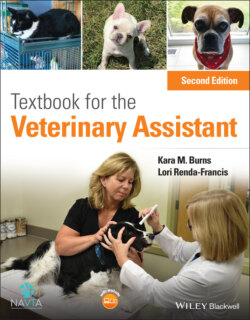Читать книгу Textbook for the Veterinary Assistant - Lori Renda-Francis - Страница 75
Chapter 5 Office Procedures and Telephone Techniques
ОглавлениеAll veterinary health‐care team members should have extensive knowledge of the workings of the hospital at which they are employed. Each employee should understand the process of making client appointments, the names of the employees at the hospital, the fee structure of the hospital, proper phone etiquette, products or brands that are recommended by the veterinarian(s), etc. This knowledge involves cross‐training amongst positions within the hospital and is imperative for veterinary assistants and receptionists as the bulk of these procedures typically fall within their responsibilities.
Communication is the key to successful implementation and understanding of office procedures. Communication is also the key to a successful veterinary hospital.
Every client and pet should be greeted when they enter the veterinary hospital. Team members should have all the medical records prepared and available for the clients with appointments for that day. As clients and pets enter, greet them with a smile and a friendly greeting. Remembering the pet’s name and greeting them upon entering the veterinary hospital makes the client feel important, remembered, and welcomed. They feel as though they are part of the health‐care team – which, in actuality, they are. This one simple step forges the long‐term relationship between client, pet, and health‐care team (Figure 5.1).
Each veterinary hospital will have guidelines for professional appearance. This is based on the premise that “you never get a second chance to make a first impression.” First impressions can be highly effective or may have devastating consequences. When meeting others for the first time, we want to establish comfort, trust, and rapport. A study from the University of Connecticut shows that first impressions turn out to be accurate 67% of the time. Clients will base their judgment of the practice and value of a veterinary hospital and its employees on the first appearance of the health‐care team and the veterinary hospital. Personal grooming and professional appearance, appropriate language, and basic common courtesy are central to making a good impression and representing the veterinary hospital for which you work. When clients meet the health‐care team for the first time, our clothing, manners, and etiquette are on display. Clients measure our self‐confidence and our ability within 60 seconds of the first interaction. Health‐care teams do not want to give the impression that team members are not self‐confident and able to carry out their responsibilities.
When considering personal grooming and professional appearance, the health‐care team must consider the safety of themselves, the patient, and their teammates and remember that each member of the veterinary hospital has the potential to have a very physically active position. Each individual must take into account everything from personal jewelry to professional clothing. Every veterinary hospital should have a standard operating procedures (SOP) manual. This will review every procedure and requirement in the hospital and will include guidelines for personal grooming and professional appearance. Hospitals vary in regard to uniforms. Some may designate scrub tops and bottoms as the uniform of choice. Others may designate colors of scrubs to certain positions in the hospital. It is recommended to wear comfortable and durable clothing that is easily washable in hot water. To decrease the risk of disease transmission, clothing should be washed daily. Every member of the health‐care team should wear a name tag which includes name, credentials, and job title (Figure 5.2). Remember patient and team member safety when choosing a name tag. Consider embroidery on the scrub top with a name or a name badge that is magnetic. Pin‐style name badges have the potential to puncture the wearer and/or patient. Insure the required information is applied to whatever type of identification the hospital and the individual approve. Open‐toed shoes should never be worn when working in a veterinary hospital. Many positions in the hospital require long days with short or nonexistent breaks, so it is important to wear comfortable and durable shoes.
Figure 5.1 Health‐care team member and client.
Source: Sirois, M. (ed.) 2010. Principles and Practice of Veterinary Technology, 3rd edition. Elsevier Mosby, St Louis, MO.
Figure 5.2 Name badge alternatives.
Source: Courtesy of Kara M. Burns, LVT, VTS (Nutrition).
The SOP manual will also give guidance for wearing jewelry, including piercings. Remember, common sense plays a big part in choices of jewelry and piercings that are worn to work. The health‐care team must think of patient and team member safety when considering jewelry. A watch that is waterproof with a seconds hand is needed when working in veterinary medicine. Other jewelry such as piercings, earrings, bracelets, and necklaces must be approved by the hospital owner or practice manager as directed in the SOP manual. There is high risk for a patient to catch their paw, claws, or teeth on jewelry, thus potentially injuring themselves or the individual. Rings pose a risk as described above in addition to potentially harboring bacteria. If rings are to be worn, the recommendation is a ring with a flat and smooth surface that may be taken off and washed frequently. Tattoo requirements will be detailed in the hospital SOP manual.
Part of working as a professional and portraying a professional appearance includes appropriate language and behavior. The language of every health‐care team member should be professional at all times. Remember common courtesy. Swearing is NEVER appropriate. All health‐care team members should be familiar with the appropriate language used when communicating about veterinary medicine.
Team etiquette should be established by the hospital and used by every member of the health‐care team. Respect is the number one requirement in a professional working environment. Respect should be given to every member of the team with whom you work and to the client. All team members are important to the success of the hospital and the care of a patient. No one position is above another when patient care and successful hospital operation are involved.
